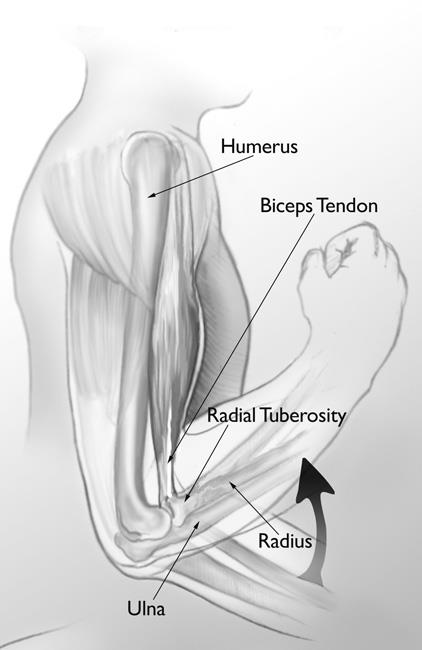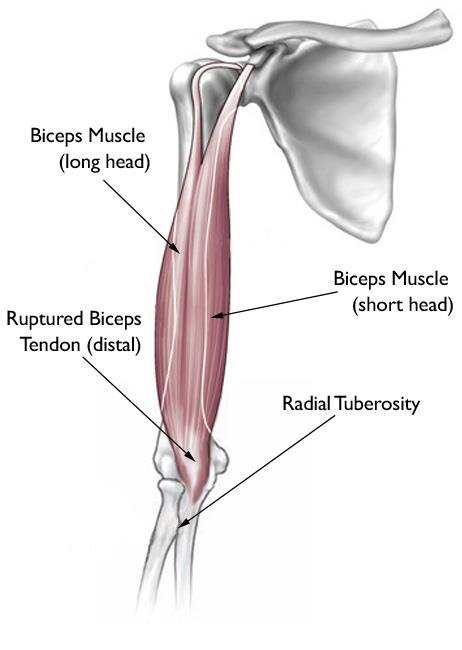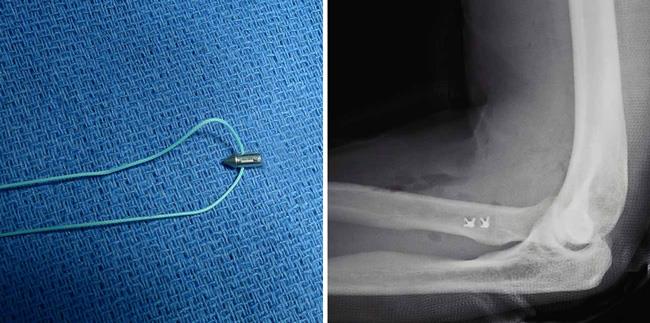Biceps Tendon Tear at the Elbow
Article Featured on AAOS
The biceps muscle is located in the front of your upper arm. It is attached to the bones of the shoulder and elbow by tendons — strong cords of fibrous tissue that attach muscles to bones.
Tears of the biceps tendon at the elbow are uncommon. They are most often caused by a sudden injury and tend to result in greater arm weakness than injuries to the biceps tendon at the shoulder.
Once torn, the biceps tendon at the elbow will not grow back to the bone and heal. Other arm muscles make it possible to bend the elbow fairly well without the biceps tendon. However, they cannot fulfill all the functions of the elbow, especially the motion of rotating the forearm from palm down to palm up. This motion is called supination.
To return arm strength to near normal levels, surgery to repair the torn tendon is usually recommended. However, nonsurgical treatment is a reasonable option for patients who may not require full arm function.
Anatomy
The biceps muscle has two tendons that attach the muscle to the shoulder and one tendon that attaches at the elbow. The tendon at the elbow is called the distal biceps tendon. It attaches to a part of the radius bone called the radial tuberosity, a small bump on the bone near your elbow joint.
Description
Biceps tendon tears can be either partial or complete.
Partial tears. These tears damage the soft tissue but do not completely sever the tendon.
Complete tears. A complete tear will detach the tendon completely from its attachment point at the bone.
In most cases, tears of the distal biceps tendon are complete. This means that the entire muscle is detached from the bone and pulled toward the shoulder.
Other arm muscles can substitute for the injured tendon, usually resulting in full motion and reasonable function. Left without surgical repair, however, the injured arm will have a 30% to 40% decrease in strength, mainly in twisting the forearm (supination).
Rupture of the biceps tendon at the elbow is uncommon. It occurs in only three to five people per 100,000 each year, and rarely in women.
Cause
The main cause of a distal biceps tendon tear is a sudden injury. These tears are rarely associated with other medical conditions.
Injury
Injuries to the biceps tendon at the elbow usually occur when the elbow is forced straight against resistance. It is less common to injure this tendon when the elbow is forcibly bent against a heavy load.
Lifting a heavy box is a good example. Perhaps you grab it without realizing how much it weighs. You strain your biceps muscles and tendons trying to keep your arms bent, but the weight is too much and forces your arms straight. As you struggle, the stress on your biceps increases and the tendon tears away from the bone.
Risk Factors
Men, age 30 years or older, are most likely to tear the distal biceps tendon. Additional risk factors for distal biceps tendon tear include:
Smoking. Nicotine use can affect tendon strength and quality.
Corticosteroid medications. Using corticosteroids has been linked to increased muscle and tendon weakness.
Symptoms
There is often a “pop” at the elbow when the tendon ruptures. Pain is severe at first, but may subside after a week or two. Other symptoms include:
- Swelling in the front of the elbow
- Visible bruising in the elbow and forearm
- Weakness in bending of the elbow
- Weakness in twisting the forearm (supination)
- A bulge in the upper part of the arm created by the recoiled, shortened biceps muscle
- A gap in the front of the elbow created by the absence of the tendon
Doctor Examination
Physical Examination
After discussing your symptoms and how the injury occurred, your doctor will examine your elbow. During the physical examination, your doctor will feel the front of your elbow, looking for a gap in the tendon. He or she will test the supination strength of your forearm by asking you to rotate your forearm against resistance. Your doctor will compare the supination strength to the strength of your opposite, uninjured forearm.
Imaging Tests
In addition to the examination, your doctor may recommend imaging tests to help confirm a diagnosis.
X-rays. Although x-rays cannot show soft tissues like the biceps tendon, they can be useful in ruling out other problems that can cause elbow pain.
Ultrasound. This imaging technique can show the free end of the biceps tendon that has recoiled up in the arm.
Magnetic resonance imaging (MRI). These scans create better images of soft tissues. They can show both partial and complete tears of the biceps tendon.
Treatment
Surgery to reattach the tendon to the bone is necessary to regain full arm strength and function.
Nonsurgical treatment may be considered if you are older and less active, or if the injury occurred in your nondominant arm and you can tolerate not having full arm function. Nonsurgical treatment may also be an option for people who have medical problems that put them at higher risk for complications during surgery.
Nonsurgical Treatment
Nonsurgical treatment options focus on relieving pain and maintaining as much arm function as possible. Treatment recommendations may include:
- Rest. Avoid heavy lifting and overhead activities to relieve pain and limit swelling. Your doctor may recommend using a sling for a brief time.
- Nonsteroidal anti-inflammatory medications. Drugs like ibuprofen and naproxen reduce pain and swelling.
- Physical therapy. After the pain decreases, your doctor may recommend rehabilitation exercises to strengthen surrounding muscles in order to restore as much movement as possible.
Surgical Treatment
Surgery to repair the tendon should be performed during the first 2 to 3 weeks after injury. After this time, the tendon and biceps muscle begin to scar and shorten, and restoring arm function with surgery may not be possible. While other options are available for patients requesting late surgical treatment for this injury, they are more complicated and generally less successful.
Procedure. There are several different procedures to reattach the distal biceps tendon to the forearm bone. Some doctors prefer to use one incision at the front of the elbow, while others use small incisions at both the front and back of the elbow.
A common surgical option is to attach the tendon with stitches through holes drilled in the radius bone. Another method is to attach the tendon to the bone using small metal implants (called suture anchors).
There are pros and cons to each approach. Be sure to carefully discuss the options available with your doctor.
Complications. Surgical complications are generally rare and temporary.
- Numbness and/or weakness in the forearm can occur and usually goes away.
- New bone may develop around the site where the tendon is attached to the forearm bone. While this usually causes little limitation of movement, sometimes it can reduce the ability to twist the forearm. This may require additional surgery.
- Although uncommon, the tendon may re-rupture after full healing of the repair.
Rehabilitation. Right after surgery, your arm may be immobilized in a cast or splint.
Your doctor will soon begin having you move your arm, often with the protection of a brace. He or she may prescribe physical therapy to help you regain range of motion and strength. Resistance exercises, such as lightly contracting the biceps or using elastic bands, may be gradually added to your rehabilitation plan.
Be sure to follow your doctor’s treatment plan. Since the biceps tendon takes over 3 months to fully heal, it is important to protect the repair by restricting your activities. Light work activities can begin soon after surgery. But heavy lifting and vigorous activity should be avoided for several months.
Although it is a slow process, your commitment to your rehabilitation plan is the most important factor in returning to all the activities you enjoy. Surgical Outcome. Almost all patients have full range of motion and strength at the final follow-up doctor visit. After time, return to heavy activities and jobs involving manual labor is a reasonable expectation.
Orthopedic & Sports Medicine Center of Oregon is an award-winning, board-certified orthopedic group located in downtown Portland Oregon. We utilize both surgical and nonsurgical means to treat musculoskeletal trauma, spine diseases, sports injuries, degenerative diseases, infections, tumors and congenital disorders.
Our mission is to return our patients back to pain-free mobility and full strength as quickly and painlessly as possible using both surgical and non-surgical orthopedic procedures.
Our expert physicians provide leading-edge, comprehensive care in the diagnosis and treatment of orthopedic conditions, including total joint replacement and sports medicine. We apply the latest state-of-the-art techniques in order to return our patients to their active lifestyle.
If you’re looking for compassionate, expert orthopedic surgeons in Portland Oregon, contact OSM today.
Phone:
503-224-8399
Address
17355 Lower Boones Ferry Rd Suite 100A
Lake Oswego, OR 97035
Hours
Monday–Friday
8:00am – 4:30pm







